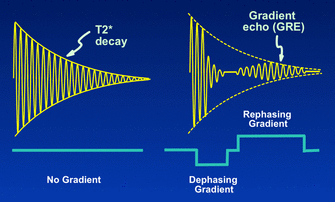|
A spin echo (SE) is produced by pairs of radiofrequency (RF) pulses, whereas a gradient echo (GRE) is produced by a single RF pulse in conjunction with a gradient reversal. The formation of a GRE is illustrated schematically. Following the RF pulse, the first negative-going lobe of the gradient causes a phase dispersion of the precessing spins. When this gradient is reversed, the spins refocus and form a gradient (recalled) echo.
|
|
|
GRE imaging differs from SE imaging in several respects. First, because only one RF-pulse is applied, the echo can be recorded much more quickly in a GRE sequence. As a result, echo time (TE) is generally shorter for GRE sequences than for SE sequences. When GRE sequences are used with low-flip-angle excitations, short values of repetition time (TR) may also be used. The combination of short TR and short TE values allows for very rapid signal acquisition. For this reason GRE sequences form the basis for most rapid imaging and MR angiographic techniques.
A second important feature of GRE imaging is that the gradient reversal refocuses only those spins that have been dephased by action of the gradient itself. Specifically, phase shifts resulting from magnetic field inhomogeneities, static tissue susceptibility gradients, or chemical shifts are not cancelled at the center of the GRE as they are in SE sequences. Image contrast is therefore dictated not by true T2-relaxation, but by these other factors which constitute T2*. GRE sequences are therefore more frequently troubled by susceptibility and chemical shift artifacts and do not function well on scanners whose magnetic fields lack homogeneity. |
Advanced Discussion (show/hide)»
No supplementary material yet. Check back soon.
References
Elster AD. Gradient echo imaging: techniques and acronyms. Radiology 1993; 186:1-8. [DOI Link]
Hahn EL. Detection of sea-water motion by nuclear precession. J Geophys Res 1960; 65:776-777. (In addition to spin echoes, Hahn also discovered gradient echoes that occurred when a gradient field was reversed described in this paper. He even went further to show how velocity could be measured based on gradient induced phase shifts, the foundation of modern phase-contrast MRI.)
Markl M, Leupold J. Gradient echo imaging. J Magn Reson Imaging 2012; 35:1274-1289. [DOI Link] (good review)
Winkler ML, Ortendahl DA, Mills TC, et al. Characteristics of partial flip angle and gradient reversal MR imaging. Radiology 1988;166:17-26. [DOI Link]
Elster AD. Gradient echo imaging: techniques and acronyms. Radiology 1993; 186:1-8. [DOI Link]
Hahn EL. Detection of sea-water motion by nuclear precession. J Geophys Res 1960; 65:776-777. (In addition to spin echoes, Hahn also discovered gradient echoes that occurred when a gradient field was reversed described in this paper. He even went further to show how velocity could be measured based on gradient induced phase shifts, the foundation of modern phase-contrast MRI.)
Markl M, Leupold J. Gradient echo imaging. J Magn Reson Imaging 2012; 35:1274-1289. [DOI Link] (good review)
Winkler ML, Ortendahl DA, Mills TC, et al. Characteristics of partial flip angle and gradient reversal MR imaging. Radiology 1988;166:17-26. [DOI Link]
Related Questions
What is a gradient echo, and how does it differ from an FID?
How do you produce multiple GRE's from a single pulse?
What is a gradient echo, and how does it differ from an FID?
How do you produce multiple GRE's from a single pulse?



